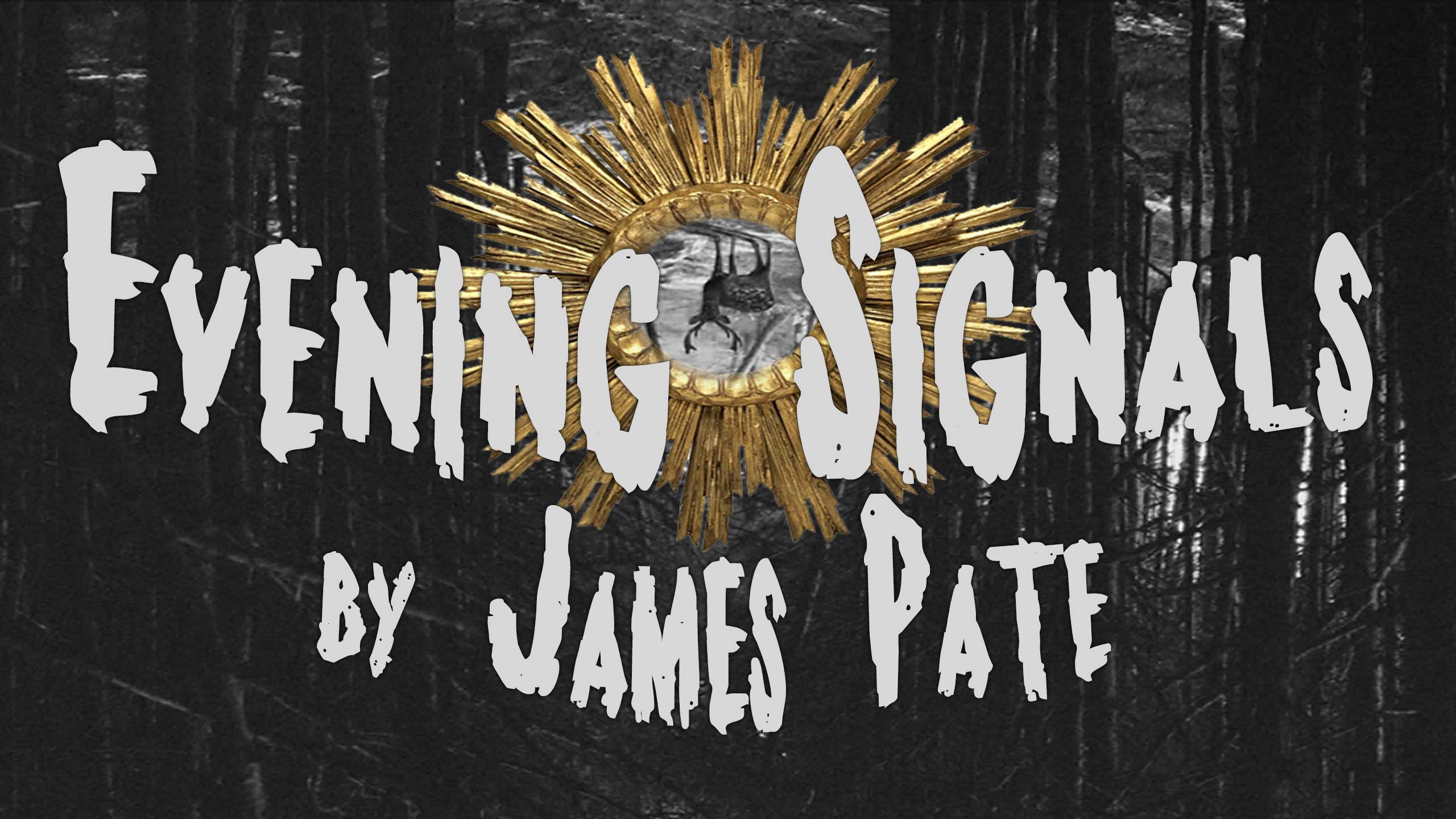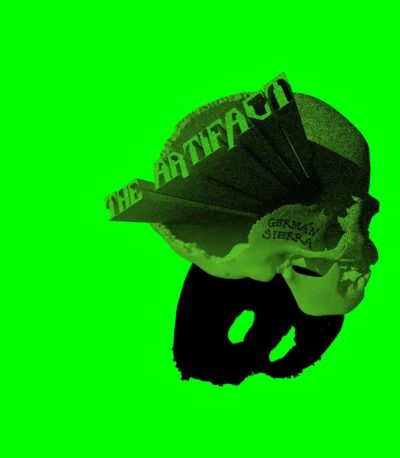Germán Sierra’s The Artifact
Evening Signals is a monthly column by James Pate, exploring the Baroque, the Gothic, the Weird and the Fantastique in contemporary poetry and fiction. This month’s column reviews Germán Sierra’s The Artifact.

Germán Sierra’s The Artifact
Evening Signals is a monthly column by James Pate, exploring the Baroque, the Gothic, the Weird and the Fantastique in contemporary poetry and fiction. This month’s column reviews Germán Sierra’s The Artifact
Naming suffering, exalting it, dissecting it into its smallest components – that is doubtless a way to curb mourning.
– Bogna Konior, “Unlearning Habitual Cosmologies: Reading Stanisław Lem at the Event Horizon”
I don’t think theory-fiction is a genre, though…The world is so chaotic that no overarching theory can ever hope to explain it. So, the form itself leaks and cracks. It becomes bent out of shape and bleeds into other genres.
– Simon Sellars, Interview with The Quietus
Afew years ago, the theorist/literary critic Gregory Marks posted a “Theory-Fiction Reading List” on his site The Wasted World. The post generated a great deal of discussion about what constitutes “theory-fiction,” and if theory-fiction should be considered a genre in its own right, or more of a sensibility. Also, like any discussion of genre, there was debate about how narrowly or how broadly theory-fiction should be defined. One of the aspects of Mark’s list I especially liked was how extensive and detailed it was – how it didn’t simply call up the expected works, but also included writers such as William Blake and Margaret Cavendish — which itself suggested that variants of what is often called theory-fiction have been around with us for a long time [1].
Genre is always a sort of fiction – a creation to add shape to (and, at its worst, regulate) the millions upon millions of texts in print and cyberspace. And the question of what theory fiction is (or might one day become) is more interesting to me than any settled definitions. Germán Sierra’s The Artifact (Inside the Castle, 2018), though, is, I think, a very clear example of theory-fiction’s general style, being a hybrid work blending and juxtaposing narrative, essayistic expositions, and spiraling flights of fancy. When I think of theory-fiction, Sierra’s book is exactly the kind of fiction that comes to mind.
More specifically, Sierra’s novel (or non-novel, or anti-novel) is part of a line of recent theory-fiction – with Reza Negarestani’s brilliantly audacious Cyclonopedia: Complicity with Anonymous Materials maybe being the most famous example – that incorporates cyber-theory, biomechatronics, the weirder and more unsettling aspects of modern physics, neuro-science, sci-fi world making and unmaking, demonology, the occult, the Fermi paradox, entropy, global market flows and disruptions, Acid Communism, a Gothic fascination with death and absence, folk horror films, obscure conspiracy theories, and the implications of AI. One common aspect of this branch of theory-fiction is the way “theory” is so intermeshed with “fiction.” Here, fiction is never used to illustrate theory. Rather, the concepts are expressed in language so particular, and in circumstances that create such specific moods and ambiences, that to try to extract the theory from the fiction leads to a reductive misreading of the text. Immanence and systems/webs, in these works, continually out-maneuvers transcendence and conceptual purity.
Sierra’s The Artifact is less a story with a linear direction than a series of intense fragments and situations, the central one involving “the artifact” highlighted in the title – a enigmatic X element found in the brain scan of a control subject. The narrator for most of the novel, who teaches at a university, receives a call from a former student who asks him to look at images from an MRI scan. When the narrator sees the image, he thinks the X element is an “artifact,” using the scientific connotation of the word, which means a misrepresentation of a phenomena due to the imaging techniques (or, more generally, the technology involved)[2]. And yet, when he reviews thousands of brain MRI images looking for something comparable, he is unable to find a similar image. One hypothesis for this anomaly – one that even the narrator himself admits is fairly far-fetched — is that it might be the first manifestation of a different dimension. “But let’s imagine,” he tells us, “something that – being material, physical, corporeal and dynamic – is not bioid. Not physiologically driven, not even determined by a circular teleological aim – you wouldn’t consider it alive…Something that might come from the past or the from the future, not because it has ‘travelled’ from there, but because it always existed in a parallel space of possibilities.” What if this opaque X, he speculates, could even replicate, creating a “superimposed tridimensional space pulsating in our world of phenomena like a glitch”? From his tone, it is impossible to tell if the narrator finds this idea terrifying, enthralling, or (the most likely) both.
Yet this description of the novel’s central thread doesn’t really convey the experience of reading Sierra’s exhilaratingly mutating work, which quickly zigzags  from one tone/style to the next. This theme of “the artifact” is explored in parallel narratives, creating more of a pattern than a plot per se. The narrator himself losses his arm when an “AI-controlled drone” crashes into the windshield of his car. His prosthetic arm is another type of artifact – this one in the cultural sense, speaking to current and soon-to-be technologies, and how those technologies will be seen, eventually, as the artifacts of our time. The narrator describes the prothesis as “a futuristic metal, ceramic and plastic arthropodal limb attached to my humerus where bones and flesh used to be sucking blood.” (Vampiric imagery echoes throughout the book.) The narrator is deeply unmoored by the experience of the accident, stating, “Agony and pleasure are featured to keep a precise image of the body’s integrity, the importance of the body as an imaginary whole able to play the game of life, to remind the nonsensical fragility of the individual.” (The narrator’s “nonsensical fragility” has to be reminded that there’s “the individual.”) But the prothesis offers a new experience of the self to the narrator, becoming his “lightning rod” that attracts “electromagnetic signals from a vast cosmic system and channeling them down to the ground through [his] wobbering body.”
from one tone/style to the next. This theme of “the artifact” is explored in parallel narratives, creating more of a pattern than a plot per se. The narrator himself losses his arm when an “AI-controlled drone” crashes into the windshield of his car. His prosthetic arm is another type of artifact – this one in the cultural sense, speaking to current and soon-to-be technologies, and how those technologies will be seen, eventually, as the artifacts of our time. The narrator describes the prothesis as “a futuristic metal, ceramic and plastic arthropodal limb attached to my humerus where bones and flesh used to be sucking blood.” (Vampiric imagery echoes throughout the book.) The narrator is deeply unmoored by the experience of the accident, stating, “Agony and pleasure are featured to keep a precise image of the body’s integrity, the importance of the body as an imaginary whole able to play the game of life, to remind the nonsensical fragility of the individual.” (The narrator’s “nonsensical fragility” has to be reminded that there’s “the individual.”) But the prothesis offers a new experience of the self to the narrator, becoming his “lightning rod” that attracts “electromagnetic signals from a vast cosmic system and channeling them down to the ground through [his] wobbering body.”
Both artifacts in the text – the X element in the MRI image, the prosthetic arm – create ripple effects, but in different directions. The X has an “amazingly stubborn lack of signification,” while the prosthetic is often described as having almost an excess of meaning (being the narrator’s “antenna,” his “lightning rod”). The Control Subject is seemingly oblivious to what might be lurking in his brain (even if what lurks there is not of our particular dimension). The narrator, in contrast, contemplates what is means to experience sensation through this technology, and how this technology reshapes his notion of self.
This tension between an artifact-as-lack and an artifact-as-surplus is mirrored in the personalities of the characters themselves. The Control Subject is described largely as cipher-like, an open-ended and generic human person – a conscious, ambulatory absence. The other characters in the book have a hard time recollecting what he looks like, and he is never given a legal name. He is spectral, through and through:
“He found himself ghostwalking around the house and then just aimlessly ghostdrove his car, turning right and left here and there until the city became a lost dimension.” His reason for becoming a control subject, for volunteering again and again for research experiments, is that it furthers his anonymity to the point where it becomes, for him, an odd liberation. We’re told, “Once you accept your role as CONTROL SUBJECT, the world opens wide to your wandering, you stay connected to reality by the needling and questioning and measuring and radiating and magnetizing they do to you.”
Like the artifact related to him, the control subject lacks signification.
The narrator, however, is an excess of signification. We’re told of his career, his love life, his morning routine (“I was drinking coffee and orange juice while checking my overnight emails on my iPhone / while reading Google news on the computer screen / while smoking a Marlboro…”). Hints are sometimes dropped suggesting that he might be involved in some type of clandestine group, telling the reader, “You’ve never heard of us before. Nothing from me. Nothing less.” But if this group is political in nature – or scientific, or governmental – is left unclear (as is the question if the group exists at all). Just as his prosthetic is symbol-saturated, the narrator himself is an accumulation of meanings, becoming cryptic and hidden in the process.
This shadowy quality is true for many of the other characters, too. One of the most intriguing figures in Sierra’s novel is a heavily tattooed mathematician who haunts a casino. She has little interest in gambling. Instead, as she tells the Control Subject, “I like the golden and red plastic flowers, and the dusty dog-chewed formerly-patterned carpets, and the fake waterfalls, and the lousy ambient music, and the jingling and shouting, and the atrocious exhibition of surveillance.” For her, the casino is a display of kitsch, and, in its profusion of color and noise, a contrast to the anonymity of numbers and big data. (Again, here, there’s the play between absence and excess.)
Sierra, along with being the author of five previous novels in Spanish, is a neuroscientist, and this background probably feeds into his ability to vividly explore these immensely complicated issues of brain and mind, materiality (both organic and inorganic) and selfhood. The Artifact is one of those novels that questions the conventional scale of commonplace realism, and opens out for the reader a wider, stranger and more quicksilver universe. As one character says, “When you look to the very big and the very small, you’re ready to find weird, unexplainable things.” Sierra’s book is an intricate illustration of the intelligences and patterns and realities from which we emerge.
Footnotes
1. A related question: what is the distinction between “theory-fiction” and the “philosophical novel”? I tend to think of theory-fiction as being more experimental and focused on form – closer to Acker’s Blood and Guts in High School than Sartre’s Nausea. But this is a fairly subjective take.
2 . At least, that’s what I think it means. When Googling the term in this sense, it’s easy to go down a rabbit hole of very contrasting definitions. I can’t help but suspect Sierra was aware of this when choosing the title.

About the Author
James Pate teaches creative writing, literature and philosophy at Shepherd University. His books include The Fassbinder Diaries (CCM, 2013), and Flowers Among the Carrion (Action Book Salvo Series, 2016). His work has appeared in 3:AM Magazine, Black Warrior Review, Burning House Press, Blue Mesa Review, Berkeley Fiction Review, and Occulum, among other places.